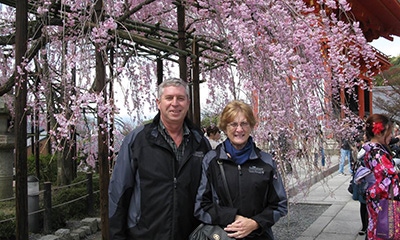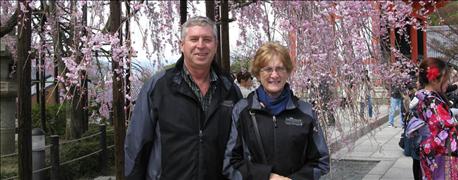March 31, 2016

Many farmers looking to expand their farms steer clear of eroded or poorly drained fields with overgrown fencerows, but for Jan Layman, those fields look like opportunities.
“I really like to get a hold of a farm with gullies or woolly fencerows and clean it up,” he explains. Jan, a 2016 Ohio Master Farmer, has been farming for the last 37 years in Hardin County, just west of Kenton.
As he expanded his acreage over the years, he bought some land at bargain prices, simply because other farmers weren’t willing to take a chance on neglected ground. “Most people don’t want to do that work,” he notes. He has also worked with landowners to revive some of his rented ground.

MASTERS: Jan and Cindy Layman, 2016 Ohio Master Farmers, have been farming for the last 37 years in Hardin County. They raise corn and soybeans on 3,700 acres.
Jan has been farming since 1979, when he was a high school senior. He and an older brother took over the family farm that year after the death of their father. At that time, the family was farming 400 to 500 acres and raising hogs from feeder to finish. They continued to feed hogs for a few years before phasing out livestock to focus on grain production. Since then, Jan and his wife, Cindy, have gradually purchased and rented more land. They now raise corn and soybeans on 3,700 acres, about a third owned and the rest rented.
His wife’s contributions have been important for the success of the farm, Jan says. “I married the right one.”
Cindy, who worked off the farm for 30 years in the Farm Credit system and banking, has the analytical know-how to complement his agronomic expertise, he says. She isn’t afraid of big-dollar figures, but she does insist on thinking things through before making investments.
“She’ll make me slow down and do some analysis,” he says. Five years ago, Cindy retired and now works full time taking care of the farm’s finances and analytical work.
Jan also relies on four full-time employees: Matthew Haun, Randy McCune, Carl Musselman and farm foreman Ron Hamilton. Among them, they handle all spraying, fertilizer applications and grain hauling, as well as planting and harvest. During the busy planting and harvest seasons, the team also includes additional part-time employees, including Jan’s brother, Jerry, who is a retired teacher.
Full-timer Haun is married to the Laymans’ daughter, Genny. The Hauns are working to add a custom fertilizer and lime application business to the farm. Their goal is to build the business to the point where Genny can work on the farm full time as well.
Long-term no-till
All the land on Layman Farms is no-tilled, except for land that needs to be leveled after drainage work. “Tillage around here is the exception, not the rule,” Jan says. The drought in 1988 helped convince him no-till had potential, he recalls. That year he had a few hundred acres of soybeans that never sprouted because of the dry weather, but a neighbor, Gary Shick, got a stand in his no-till fields. “I thought, ‘Boy, there’s something to this in terms of moisture.’” The Layman farm was growing rapidly in the late 1980s and early ’90s, so Jan was also interested in the reduced labor requirements of no-till.
By using no-till, Jan has protected his soil from erosion, but he says good drainage also contributes to soil conservation. With his own bulldozer, pan and trencher, he and his employees repair gullies, build grass waterways and install subsurface drainage lines. He has been pattern-tiling poorly drained fields using 40-foot spacing and is seeing both conservation and yield benefits. “Until you pattern-tile a field and see the difference, you don’t understand it,” he says. In addition to doing his own earth moving and drainage work, Jan and his crew do custom work for other area farmers.
Layman Farms has storage for a year’s worth of grain production. Every bushel harvested goes into storage to take advantage of marketing opportunities during the year. The farm also earns premium prices for soybeans by raising non-GMO varieties for a company that exports them to Japan.
Variable-rate fertilizer applications
To make the most of the fertilizer he applies, Jan has been using variable-rate fertilizer applications for more than 10 years. “It’s been so long I don’t remember doing it the other way now,” he says. Early on, he took a close look at the amount of fertilizer he was using with variable-rate application compared to straight rates. “We were using about the same amount; we just put it in different places.”
At first, Jan had fields divided into 15- to 20-acre zones for soil sampling and fertility management. But three years ago, he began working with a new soil consultant who recommended he switch to a grid-based system using half-acre blocks. The change showed he had been needing lime in many of those blocks. “In the last three years, I’ve applied more lime than I had in my whole life,” he says.
To manage the variable-rate application, Jan uses a cloud-based prescription farming system that allows him to wirelessly send prescriptions to machines in the field and send application maps from the field back to the farm office.
Tech worth cost
Precision farming technology requires an investment, Jan says, but some of the tech pays for itself. For instance, the swath controls on his sprayers prevent overlaps and reduce chemical use.
On his planter, point-row clutches save seed and eliminate double-planted areas, which often don’t yield well. And while autosteer doesn’t offer direct financial benefits, it does reduce operator fatigue.
In addition to farming, Jan has an auctioneering business and acquired a real estate license 10 years ago, allowing him to handle land auctions.
Local charities and organizations often call on him to help with fundraising auctions, and he has been helping run a consignment auction to benefit the Hardin County Fair for 29 years.
Jan has been active in local and state ag organizations. He’s a past member of the Ohio Soybean Council and serves on the Ohio No-Till Council. This summer he will be hosting the Ohio No-Till Field Day Aug. 31.
Meet the Master Farmers:
Jan and Cindy Layman
You May Also Like




